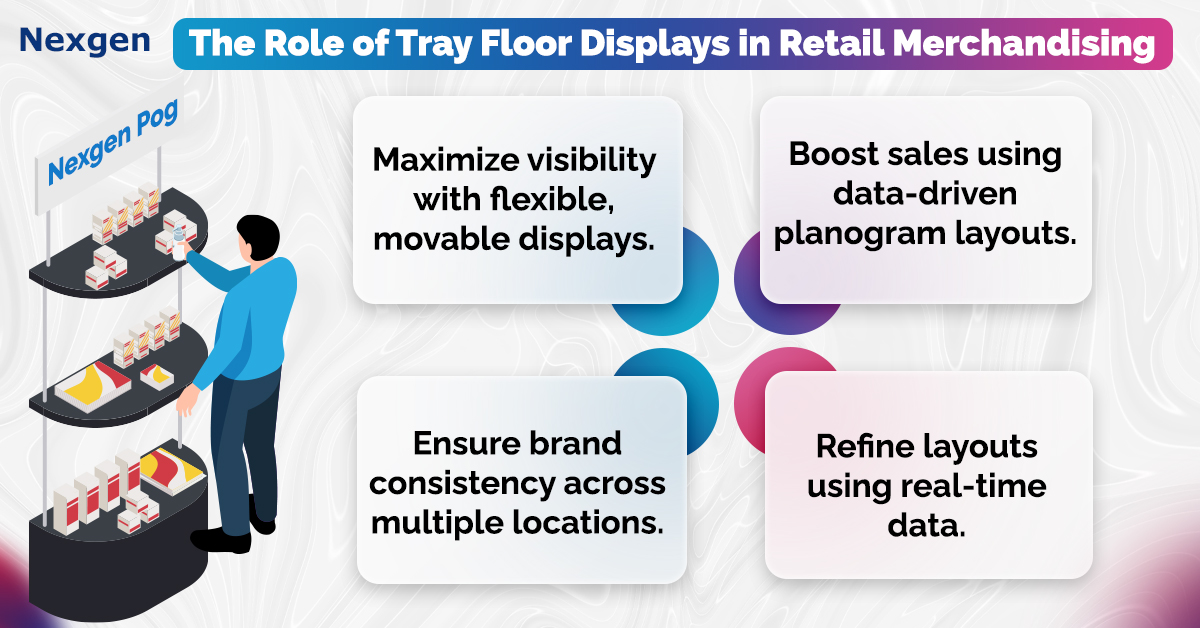In the dynamic landscape of retail, tray floor displays have emerged as versatile merchandising tools. Their portability, visibility, and flexibility make them a favorite for showcasing products in high-traffic areas. When paired with planograms, tray floor displays can elevate retail strategies, ensuring optimal product placement and increased sales. This blog explores the pivotal role of tray floor displays in retail merchandising and how a planogram perspective enhances their impact.
What Are Tray Floor Displays?
Tray floor displays are freestanding units designed to hold and present products. They come in various shapes and sizes, making them suitable for diverse retail environments. Popular for their ability to attract attention, tray floor displays are often used for:
- Promoting seasonal or limited-time offers.
- Featuring new product launches.
- Highlighting high-demand items or impulse buys.
Benefits of Tray Floor Displays
Tray floor displays offer several advantages, including:
- Flexibility: Easy to move and position, these displays allow retailers to adapt quickly to changing store layouts or promotional strategies.
- Enhanced Visibility: Placed strategically, they draw customer attention to specific products, increasing the likelihood of purchase.
- Cost-Effective Merchandising: Tray floor displays are often an affordable way to create eye-catching presentations without significant investments in permanent fixtures.
How Planograms Transform Tray Floor Displays
While tray floor displays are effective on their own, integrating them with planogram amplifies their potential. Here’s how:

- Optimized Product Placement: Planograms provide a data-driven approach to arranging products on tray floor displays. By prioritizing high-demand items or complementary products, retailers can maximize sales opportunities.
- Consistency Across Locations: For multi-store retailers, planograms ensure that tray floor displays are set up uniformly, maintaining brand identity and shopper experience.
- Improved Shopper Navigation: Strategically placed displays, guided by planograms, help direct customer flow and make key products more accessible.
- Data-Driven Adjustments: Planograms enable retailers to analyze sales data and refine the placement of products on tray floor displays to reflect current trends and preferences.
Designing Effective Planograms for Tray Floor Displays
To leverage planograms for tray floor displays, consider these steps:
- Analyze Product Performance: Use sales data to identify which products are most popular or need a promotional push.
- Prioritize Eye-Level Placement : Ensure that the most desirable items are positioned at eye level to catch shoppers’ attention.
- Create Thematic Displays: Align tray floor displays with seasonal themes, special events, or promotional campaigns to create a cohesive in-store experience.
- Leverage Color and Branding: Incorporate vibrant colors and branded elements in the planogram design to enhance visual appeal and brand recognition.
- Monitor and Optimize: Continuously evaluate the performance of tray floor displays and adjust the planogram as needed to maintain relevance and effectiveness.
Success Stories
Retailers across various industries have seen significant benefits by integrating planograms with tray floor displays. For example:
- A convenience store chain reported a 20% increase in snack sales by using tray floor displays at checkout areas, arranged according to a data-driven planogram.
- A cosmetics retailer boosted impulse purchases by creating themed tray floor displays for seasonal products, strategically placed near store entrances.
- A grocery store successfully promoted a new beverage line by dedicating tray floor displays to the product, guided by a planogram to highlight its flavors and packaging.
The Future of Tray Floor Displays in Retail
As retail evolves, the role of tray floor displays will only grow in importance. With advancements in technology, such as AI-driven planogram solutions, retailers can achieve even greater precision in product placementand merchandising strategies. These tools will enable real-time adjustments based on sales data, shopper behavior, and emerging trends.
Overview of Nexgen POG
Nexgen offers store-specific planograms for clients that optimize sales and achieve category objectives. We create customized planograms for your business to ensure that these are better aligned with your goals and merchandising strategies. Our expertise in planogram automation helps us build planograms faster, better, and consistently. Whether it is creating a planogram from scratch, or a typical reset, we have the knowledge, tools, and experience to get the job done for you.
Get Your Free Trial Today!